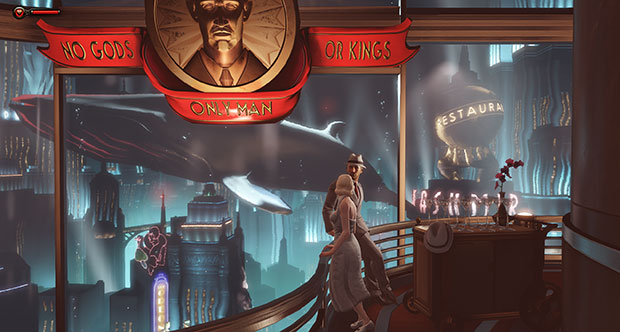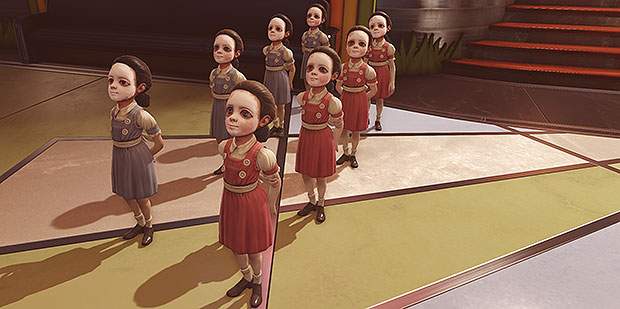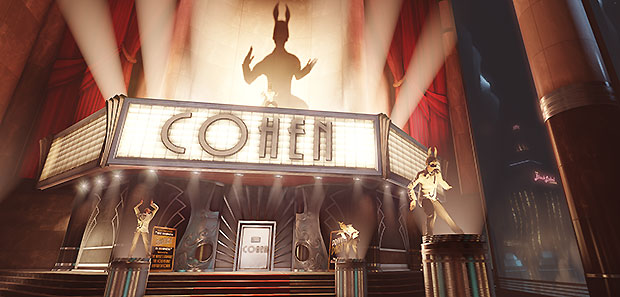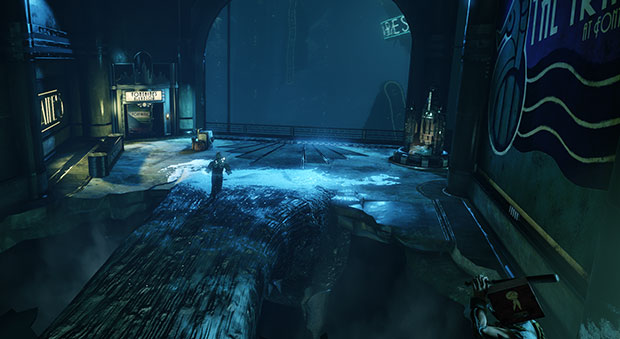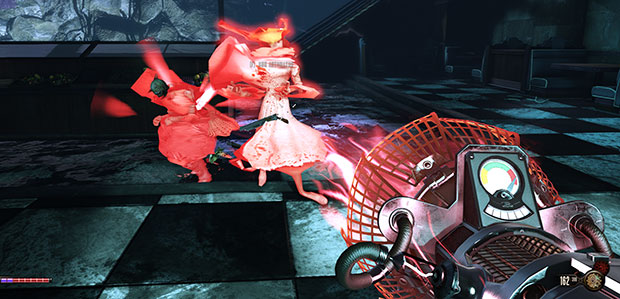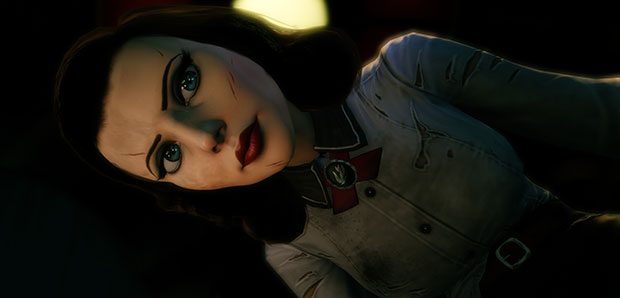Wot I Think - Bioshock Infinite: Burial At Sea Episode 1
She's there watching for me
Please note that while this piece contains no overt plot spoilers for any BioShock game, it does feature some allusions to their major events and does presume at least some familiarity with them.
"The problem with utopia is it's still full of people." A fair sentiment indeed, but is it truly spoken by a dispossessed citizen of the fast-failing undersea brains trust that is Rapture, or is it a BioShock Infinite developer lamenting that they need to somehow insert humanity into their singularly lavish shooty-bang game?
It is wonderful to be back beyond the sea, but things are different now.
This first of a two-part DLC storyline expansion shifts Infinite's two lead characters, without immediately stating whether they are the same pair or dimensional alternates, from the skies of 1912 to the seas of 1958, and thus we can return to Andrew Ryan's intended paradise/refuge for the world's brightest minds. We return to a Rapture now more striking than ever, thanks to its being apparently rebuilt rather than recycled in BioShock Infinite's fancier variant of the Unreal engine. Better still, we can experience it before it turned to ruin and decay. For a time, at least.
I've always maintained that Rapture is a more compelling, more convincing place than its airborne alternate, Columbia - equally as absurd, but its self-contained, bubble-like nature, its secrecy and its intelligentsia arrogance somehow make more sense than a flying battlestation filled with religious zealots. And when it comes to foes, its are drug and gene mod-raddled madmen rather than murderous policemen or indiscriminate guerillas; less life-like perhaps, but any inhuman action or unthinking aggression they might perform is that much easier to shrug off as the result of the monstrosity resulting from their unchecked Adam addiction. Game logic, eh?
Back beneath the waves, BioShock can offer me its greatest triumph and its greatest failing.
Rapture! An Other Place this generation of game-players will likely remember forever.
Rapture! A place we admire even despite its inevitable fall to civil war, genetic perversion and violent self-interest.
Rapture! Home of Big Daddies, Little Sisters, Andrew Ryan and Sander Cohen. We will remember them.
Rapture! Jazz and Rockwell, cigarettes and masques, hedonism and art. No gods, no kings, no prophets, no birds allegorical or otherwise, no robot George Washingtons1. Only man. And a sort of vaguely malevolent magic sea slug, but I don't think anyone's entirely comfortable talking about that any more.
But as with Columbia, the problem is the attempt to have the monsters co-exist with the men and women of a supposedly functioning city. Infinite's approach was to simply clear the stage of non-violent life whenever weapons were wielded - a clean switch for sure, and some have defended it as an open admission that the place was consciously a theme park rather than a community, but for me it meant great dissonance. Where is everyone going to? How can the people in this part of the city be so content and unworried when two minutes away there are crazy bastards and open conflict everywhere2?
Sadly, Burial At Sea's long-awaited demonstration of Rapture at its opulent peak pulls the same trick; whether it's one of technological necessity or deliberate design I of course do not know. It begins by giving me exactly what I wanted, though, and so lavishly that I cannot complain about the 'value' of this add-on. A simply marvellous prologue, of sorts, gives us a tour of the undersea 50s alterna-city with all the glamour and glitz and smarm and indulgence you might expect.
Every light works, no signs or tables or windows are smashed, the large, open bars are peopled by well-dressed cocktail-suppers, an openly gay couple admire the ocean view, a waiter uses Plasmid powers to teleport from table to table, a tranquil, upmarket music shop plays Django Reinhardt3 from its finest gramophone, citizens coo at and speculate about the true nature of their hulking, silent, diving-suited maintenance men and you think "yes, I want to be here. Even though I know what's around the corner and of the rot which lies underneath all this, even if I cannot have a conversation with any of these glamorous automatons, I want to be here."
It is beautiful here; no more so than Columbia, perhaps, but there's something about the sea, the incongruity of seeing its mysterious expanse and its silent denizens behind every window, that the sky just can't match. Also, the bins aren't inexplicably full of money, which makes more of a difference to atmosphere than it perhaps should.
Rapture! It is not the home of a paranoid cult and social oppression, it is style and ambition, a genuine and at least partially successful attempt to create metropolitan paradise. Columbia was rotten from its inception, whereas Rapture went wrong over time, as greed for wealth and power steadily crept in and the short-sightedness of the entire project was damningly revealed. While it might not quite have the power of the first game's opening, the first twenty minutes of Burial At Sea restores Rapture's glory more than simply thematically.
Even the plot, the mystery, the Elizabethness, that thing which devoured so much of Infinite, is sidelined by the sight of this place, so familiar but so new. Dark does sit alongside the light, though perhaps Rapture's smirking citizens don't see it - but we, the BioShock player, know what's really going on with the Big Daddies and the Little Sisters, what the references to missing girls and the power struggle between Ryan and Fontaine really mean, and what will become of all this. I felt privy to a secret, and able to move through heavenly Rapture both admiring it and fearing it.
Then it ends. Then a Bathysphere takes you to another part of town, through the deep dark sea, into an airlock and when the door opens the lights don't work, the signs and tables and windows are smashed, the large, open bars are peopled by corpses and blood and ammunition and shadow and ranting, muttering Splicers, and suddenly the lower quarter of your screen is taken up by an enormous gun and you know you won't see that glamour, that glitz, that razzle-dazzle any more. A few minutes ago, Sander Cohen bade us dance. Sander Cohen being Sander Cohen, it was not a dance done by choice, and it had a grim conclusion, so it did at least provide a mezzanine between Rapture in light and Rapture in darkness. But still.
It's sad to lose it, sad to know that once again, one of gaming's greatest ever places exists only for gunplay. Oh, the things they could have done here. The things they teased us with - a quest, an honest-to-God quest wherein you, as some incarnation of Booker DeWitt, steal into a series of shopkeepers' back rooms in search of a particular item while some, more sombre incarnation of Elizabeth distracts them with expertly faux-ditziness or outrage or exaggerated sensuality. A Cohen art installation, something out of Bowie in his most coke-fevered and ostentatious days, is an applause-worthy sight: a snarling ego given infinite resources and infinite power, grandeur and sadism writ its largest, a videogame developer's art budget maxing out in spectacular fashion.
Perhaps that's why this entire add-on is so short, at around 90 minutes: so many resources, so much money, I can quite imagine it would be hard to sustain for long. While I lament the length, my understanding of what 'DLC' means was deftly rewritten as titanic projected Cohen-faces stared down at me, as the vast shadows of sinister dancers flickered on the towering walls, as rabbits capered through the destabilising purple light. Yes, Burial At Sea contains perhaps the finest sights of the entire BioShock series, and it does this not by simply calling back to the first BioShock, but by visually punching as hard as it can.
What folly then, to give us a tease of what Rapture, what Burial At Sea, what BioShock could be, of smartly-written gaming tasks in peacetime, and then... And then the lights go out, the entire world switches from celebration to chaos, and the change comes not from a New Year's Eve revolt but by taking a glorified elevator to an adjacent building. Rapture's fall, it turns out, was nothing more than a loading screen.
Of course, I didn't expect it to be any different. I didn't expect the nature of this videogame to dramatically change in an add-on pack. I knew what was coming, and I knew that the lower or right quarter of every screenshot I took past a certain point would be The Gun. To some degree, while I hoped for more blending or at least frequent switching with glamorous calm, I even welcomed it - the more exaggerated, high-velocity combat of Infinite in the claustrophobic, sinister tunnels of Rapture.
It does make a difference, it does feel different from the open skies and arenas of Columbia. Enemies are heard before they're seen, that wonderfully creepy Splicer dialogue as masked, hunched figures stagger and scuttle around dark bars and flooded department stores. Stealth even plays a heightened part, as unaware Splicers can be downed in secrecy by a crouched Skyhook blow, or a massed wander into a Plasmid trap. I spent so much more time hidden, creeping and flanking than I ever did in Columbia, and I found I could use guns relatively infrequently thanks to the combination of BioShock's enclosed, dark spaces and BioShock Infinite's speed making melee combat a particularly powerful tool. I preferred it, and its darting and sneaking, to both the hectic combat of Infinite and the ponderous combat of BioShock.
While it clearly evokes BioShock, and is Rapture, there is far less use of tunnels, and more of large, clutter-strewn spaces on multiple levels, peppered with potential for traps. Enough space for strategy, enough obstacles for semi-stealth, a fine hybrid of two games. Even down here in the darkness, the artist still rules too - every room is filled with faux-period detail, 50s-themed advertising on a grand, Tim Burtonesque scale, or the mundane made sinister. Rarely does a shooting game demand screenshotting to this extent.
And when a Big Daddy appeared, as I knew he would, the old man truly was frightening again: thunderous and unstoppable, a bloody rhinoceros, all rage and determination, and despite no face and no speech, all the humanity of a being charged to protect the frail no matter the cost. What a creation he was, and I'm so glad to discover, still is.
Less effective in its return is the now well-worn routine of finding specific Plasmids in a specific order to open specific doors. Red key for red lock, yellow key for yellow lock again; perhaps, this time, it might have been better to start with a full set of powers and allow for sandbox violence from the moment The Gun arrived. The Gun, those guns, do of course feel similar - oddly homogeneous and sticklike machines of death rather than fluidly responsive or distinctive. The exception there is a new radar gun, a micro-dish with which to fry enemies with microwaves. It feels like it's fallen out of Fallout, but it's a giggle, and devastating too. Sadly it shows up so late in this short adventure that there are limited opportunities to use the thing.
When this first chapter of Burial At Sea ends, far too soon, it does so with an inevitable cliffhanger and a return of sorts to Infinite's over-arching story. It's a reminder that Rapture is now just a small piece of that puzzle rather than being lead actor in this performance.4 Two-part Burial At Sea may be, but the failure to be a standalone tale in any sense leaves it left standing in the shadow of BioShock 2's self-contained, more lore-free add-on, Minerva's Den. Given this and given its brevity, splitting Burial At Sea into two parts does look suspiciously like Peter Jacksonesque greed, as counter to expectations as this DLC's lavishness might be.
There's a sadness to that as much as there is to our limited time with a fully-operational Rapture, but at the same time Burial At Sea is extremely effective at posing big, gnawing and dramatic new questions to a riddle we thought answered. I am so very hungry for part two, but I do hope it gives us more Rapture-in-light as well as answers, self-reference and metatextuality. Burial At Sea's visually and sonically breathtaking first act proves it can be done, at least briefly, so I know I'm not being - hah - irrational to request it. I hope also that Rapture is left with an identity of its own when all of this is done, that it isn't subsumed completely into the story of the girl and the debt. Somewhere in this undersea town, there's a man I'd like to talk to, a man yet to share his golf clubs. I'd love to know what he makes of all this.
Footnotes
1. Actually, one does make an incongruous appearance in this DLC, via Elizabeth's Tears - she pulls robo-allies from other realities, as in Infinite, which just about justifies the recycling. There are also robotic Samurai, for some reason.
2. Mind you, I've visited enough of San Francisco to know that's not entirely removed from the realm of reality.
3. If you don't know him, you should.
4. There are no shortage of allusions to Infinite's events throughout Burial At Sea, however; this Elizabeth seems to carry some knowledge of the past even if this Brooker is as befuddled as the last one. Regardless of this dissonance, both quickly fall into the easy, familiar routine of Infinite's AI buddy system, the Tears and the lockpicks and the lobbing of supplies.
Burial At Sea Episode 1 is out tomorrow, and will cost a mysterious amount of money.



